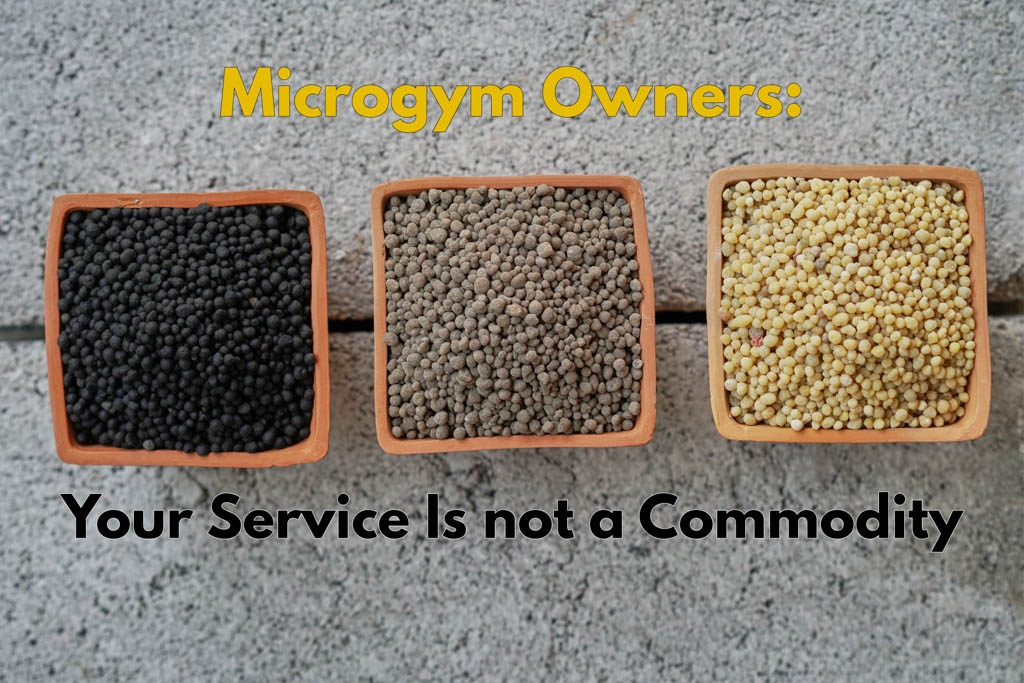In the first article in this series, I wrote, “You don’t sell group training. You coach people. Sometimes you coach them in a group setting. Let’s start with that mindset and build on it.”
There’s a lot of competition in the group training space now. This is because we’ve figured out how to get results for people: intense exercise and a sound diet.
Many new gym franchises have emerged from that simple recipe. They charge low rates, work in small spaces and sell a service that looks the same as what most microgyms sell. They’ve commoditized intensity. And that has a lot of microgym owners worried.
The microgym owners who suffer when a new Orangetheory opens nearby are the ones selling group training and nothing else. Because Orangetheory is going to win at that game. But our business isn’t actually the same as their business.
Here’s how to set yourself apart.
Forget About This Stuff
First, here’s what you don’t sell:
Programming
No one is seeking out the best group programming. People look for the workouts that will benefit them most—including beginners and Games athletes.
Bad programming can cost you clients. Good programming doesn’t add clients.
Relationships keep clients. Sell your relationships.
Programming isn’t a differentiator between your gym and the franchises.
Community
Like programming, bad culture in your gym can cost you clients. But good culture doesn’t add clients.
Relationships between clients are important. But not as important as the relationship between each client and each coach.
Your clients are not 50 percent nicer than Orangetheory clients. Their coaches are taught how to be warm and engaging first and how to teach the squat second. Community is not a good differentiator between your gym and the franchises.
Access to Equipment
You know who sells 24/7 access to equipment? The gyms with amazing equipment, 10,000 clients and no coaching.
When you sell 24/7 access to equipment, you begin to compete with Gold’s Gym. And you’re not going to win that one. Take it from someone who’s tried.
Selling access means surrendering coaching control of your clients. It causes clients to misinterpret your real value, argue about access during class times and leave when rules aren’t enforced the same way every time. Selling 24/7 access won’t help you keep the right people around; it will just help you attract the wrong people for short-term commitments.
Group Exercise
Pay your membership, show up when you like—that’s not a winnable model for microgyms.
Who sells that stuff? Orangetheory. Fit Body Boot Camp. F45. Les Mills. Jazzercise. Models built on a low-paid group leader (I won’t use the term “coach”) and a choreographed workout set to music.
These franchises have good branding, big classes and low overhead. They don’t need to know Mary’s background, only that she’s paid her membership. She doesn’t add to the group by joining or subtract from the group by leaving. The programming doesn’t change whether Mary shows up or not. The coach works no harder or less hard if Mary’s in the room. The system doesn’t change because of Mary.
That’s the definition of a commodity. And every commodity has downward price pressure. These big chains have enormous advertising budgets. They can spend more and make less per client. Their margins can shrink to almost nothing and they’ll still survive. They can have high churn and still be profitable. But you can’t.
Let’s go in the other direction: toward specialization.
Stand out From the Crowd
Here’s what you really sell:
Personalized Exercise and Nutrition Plans
You design workouts and meals that will get Mary the specific results she wants. You are selling the solution to her specific problems.
Ideally, she’d train 1:1 with you every day. You’d talk to her about her meals every day or even provide them to her. But few people can afford those options.

A less-expensive option is to train Mary and the person who shares her meals at the same time. That way, you can provide the same guidance and they can split the cost.
Even less expensive: Train Mary and a small group of people with the same goals and eating habits together.
And finally, if Mary can’t afford anything else, your least expensive option is to put her in a group of people with similar goals.
You train people. Sometimes they work out together. But their overall plans should be different. That’s why you have goal-review meetings. Download our full retention guide here to read about how these meetings work.
Accountability
You don’t sell memberships. You sell results.
Results depend on two things: knowledge and action.
Knowledge is cheap: I can find workouts online. Or I can attend a group workout on Zwift.com. Or I can show up at Orangetheory and just let them tell me what to do.
I can buy a diet book. Or I can buy prepackaged low-calorie meals so I don’t even have to learn anything.
Action is the hard part: Most people don’t actually want to show up. Not every day. Most people don’t want to prep their meals or buy broccoli.
That’s where you come in.
Decisions
“I love Catalyst because I can turn my brain off for an hour.”
When I heard those words for the first time, I was shocked. But now I hear it all the time because I ask, “What do you like best about my gym?”
People want me to make decisions for them. Because they already make too many—what to wear, what to say to the boss, what to put in that expense report. They don’t want to decide how to scale the workout appropriately; they want me to tell them.
Care
How often does the average person hear, “Good job!”
Or, “It’s great to see you!”
Or even, “I’m glad you came!”
In an average day, probably not at all. That’s part of the reason people come to your gym: They know you like them. Because you tell them so.
They know you have their best interests in mind. You won’t let them do the wrong thing—including wasting their money or time.
Perspective
A coworker is raving about a new diet. Should the person try it?
You already know the answer. Your client don’t have to waste time or money or painful effort on randomness. You’ll tell him or her exactly what to do.
Course Correction
If your program isn’t working, you’ll figure out why and give clients something else.
When people hire a coach, they don’t expect the coach to be right 100 percent of the time. But they do expect the coach to correct their course when they go off track.
I once shocked a bunch of gym owners by sharing that I sometimes tell clients to take a few months off from Catalyst.
Sometimes I say, “Take the summer away from the gym. Exercise every day—walk, run, bike or swim. Read 10 books.”
Does that prescription cost me money? Absolutely. But it’s the best thing for the client. And that’s my job.
As a secondary benefit, these clients tend to stick around longer because they know they can trust me to tell them the truth—even when it’s not in my financial best interest.
Build Relationships
These things all require a 1:1 relationship with the client.
Building a business means building systems that provide these things and hiring people who deliver those systems really well.
We teach you how to build these systems in the Incubator.
And we hold you accountable for doing the work, too.
Other Articles in This Series
Are You Already too Big?
Selling Accountability
Ascending Your Clients
Don’t Skip “LEG” Day

